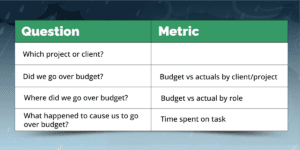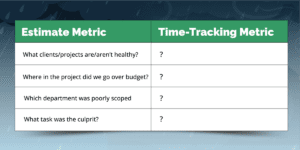How savvy agencies set themselves up to scale
In the fifth session of The Secrets to Making Your Agency Profitable series, Parakeeto Co-Founder and CEO Marcel Petitpas discusses a fundamental problem so many digital agencies face: Running to tools to try to solve reporting and measurement problems without addressing the strategy behind the tools first.
DOWNLOAD your copy of the definitive agency profitability playbook and make more informed decisions driving the growth of your agency today.
Petitpas asks, if you don’t have clarity on what the tools are supposed to give you in terms of data, then are you in a good position to be evaluating whether a tool is right for your agency?
The answer is no.
Petitpas shares exactly how to do the work that’s needed to determine what data you’re trying to get out of a tool. This will enable you to effectively evaluate your current tooling and determine whether you need different tools to track reporting and measurement (and ultimately improve profitability).
The keys to scaling your digital agency? Scoping accuracy and time tracking.
Many digital marketing agencies like yours struggle with having a clear vision on how to measure performance. They also face messy data and systems, which only compound the issue. Fortunately, with Marcel Petitpas’s advice, you can begin properly setting up your systems and tools in order to eliminate these challenges.
Setting up the right strategy to investigate a profitability problem
Your accountant rushes into your office, frazzled, and exclaims, “We have a profitability problem!”
What do you do?
How do you go about investigating that? It can be nearly impossible to determine why you’re struggling to make a profit on projects if you don’t have time and cost tracking structure alignment.
If your time tracking tasks aren’t aligned with how your estimates are set up, your team will likely be making guesses about scope. It will come as no surprise that you have a profitability problem if those estimates are off.
When you have perfect alignment between how your estimates are created and how your time tracking tool is set up to track data, it’s a different story. It’ll be a lot easier to not only create more accurate estimates but to investigate profitability problems that may arise.
Designing the right system to align estimates and time tracking
To wrap your head around how your scoping and time tracking system should be structured, use Parakeeto’s Incident Investigator™ exercise. When thinking about this exercise, consider a scenario where you have a project that went totally off the rails. Consider which questions you’d want to ask to determine what went wrong and why your profitability was so bad.

Now, consider how you should structure your data in your time tracking tool, so you can start running through these questions in your own agency with real clients and projects.
Parakeeto’s Time Tracking Mapper™ may help. Use the exercise below to think about whether the line items on your estimates map to your time-tracking tool. Which time-tracking objects match which estimate metrics in your agency?

Managing complexity in data
Petitpas shares one important note when setting up your time tracking tool: beware to manage complexity.
There’s this idea that precision equals accuracy. If you can be more precise and detailed, if you can know exactly how much time was spent on a subtask within a task within a deliverable within a milestone within a phase within a project, then that more precise data will let you be more accurate.
Right?
Wrong.
In fact, the opposite is true. It gets infinitely more expensive to get your team to track time at that level. What’s more, compliance in time tracking will go down with each layer of complexity you add to time tracking. You’ll then face more inconsistent data and have more buckets of data to contend with.
Often, agencies over-index on precision where they reach a point of diminishing returns, where being 5 percent more precise adds 0 percent additional accuracy to the high-level insight you’re trying to get. The more you try to increase the level of precision, the higher the cost and complexity.
When you go in and determine how you should use your time tracking tool, and which pieces of information you need on every time entry so you can match it back to the estimate, start with the simplest viable solution.
Track by:
- Client
- Project
- Use type tags for common projects (e.g., Website Builds)
- Role
- Use a few major buckets (e.g., Project Management, Content, Design, Development)
You don’t want 500 unique tasks estimated for a project that you somehow then have to align to in your time tracking or project management tool. You want to put all those tasks in bigger buckets, like Design and Development, so you can map them back to a data scheme. As Petitpas explains, “You need some mechanism to group discrete tasks back to broader buckets to build data models around them.”
Don’t break it down any further than the example above. That’s the key to getting started: Keep it simple to start and get your team on board. Then you might realize that you don’t need any additional data or you might see where you need to drill deeper.
Ultimately, less complexity is better to start, so you can get compliance up before you go deeper. Petitpas explains, “If you can just have a conversation with the team to determine where you went over budget, that’s a much easier way to get insight than tracking extra layers of data that can’t provide the why.”
Using reference-class forecasting to accurately measure projects
To set up this new system, you must clearly define each part of the structure: clients, projects, and roles/tasks. You also need to ensure this structure is used consistently across projects and that your time tracking or project management tool can measure these data points.
If this is done consistently over time, and if you have this structure really well-defined, you can then improve your estimates with reference-class forecasting.
Reference-class forecasting is based on a set of historical data, and the key is to understand the reference classes, such as how much design time is required on website projects.
With very little data, such as 5, 6, or 7 projects under your belt using your new structure, you can have a really reliable data line that can improve estimation efficiency and accuracy. You’ll be able to clearly see how much time was required for projects vs the budget in the past. This can eliminate bottoms-up guesswork, and it offers a faster and more accurate way to measure projects that require almost no context or expertise.
Closing the gaps and increasing profitability
The data can never tell us why the data is, it can only tell us what it is. This can leave gaps that need to be filled.
However, once we have the right strategy, structure, and data, we can start to fill in the gaps on detail by using reporting, feedback, and process optimization.
At the end of the project (or monthly for recurring projects), run a report to determine the estimate vs the actual and ask:
- What happened?
- Why did it happen?
- What can we learn?
This can close the gap. Remember: A conversation with the team is a far richer way to get context. Sometimes it’s best to rely less on precise data and more on conversations with your team to determine how to improve the efficiency of your business.
With this information, you can then conduct process improvements to continue to increase profitability on projects and scale your agency.
[adrotate banner="280"]

